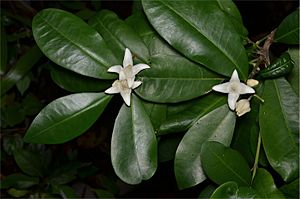Pinkheart facts for kids
Quick facts for kids Pinkheart |
|
|---|---|
 |
|
| In Tondoon Botanic Gardens, Gladstone | |
| Scientific classification | |
| Genus: |
Medicosma
|
| Species: |
cunninghamii
|
| Synonyms | |
|
|
Pinkheart, also known as bonewood, is a type of shrub or small tree. It belongs to the Rutaceae family, which includes citrus plants. This plant grows only in eastern Australia. It has long, narrow leaves and small white or cream-colored flowers.
Contents
What Does Pinkheart Look Like?
Pinkheart is a shrub or small tree. It usually grows to be about 1 to 2 meters (3 to 6.5 feet) tall. Its new branches have tiny, star-shaped hairs.
Pinkheart Leaves and Flowers
The leaves are long and narrow, shaped like a spear. They are about 45 to 230 millimeters (1.8 to 9 inches) long. They are also 15 to 75 millimeters (0.6 to 3 inches) wide. Each leaf has a short stem called a petiole, which is 5 to 20 millimeters (0.2 to 0.8 inches) long. The leaves are a dull green color and have many small oil dots.
Pinkheart flowers grow in small groups. Each group is about 15 to 90 millimeters (0.6 to 3.5 inches) long. Each flower sits on a tiny stalk called a pedicel. This stalk is about 2.4 to 12 millimeters (0.1 to 0.5 inches) long.
The flowers have small leaf-like parts called sepals. These sepals are 3 to 5 millimeters (0.1 to 0.2 inches) long. They are covered with soft hairs on the outside. The petals are white or cream-colored. They are 9 to 17 millimeters (0.4 to 0.7 inches) long. The petals are soft and hairy, especially on the back. They stay on the plant even after the fruit grows. They can grow larger, up to about 20 millimeters (0.8 inches).
When Does Pinkheart Bloom?
Pinkheart usually blooms from November to June. The fruit is small, about 5 to 6.5 millimeters (0.2 to 0.3 inches) long. It is often hidden by the petals that remain on the plant.
How Pinkheart Got Its Name
Pinkheart was first officially described in 1842. A botanist named William Jackson Hooker gave it the name Acronychia cunninghamii. He published his description in a science magazine called Botanical Magazine.
The Plant's Discovery
The first plants used for this description were collected by Allan Cunningham. He was an explorer and botanist. He found them near Moreton Bay in Australia. Seeds from these plants were then grown in Kew Gardens in England.
Changing the Name
Later, in 1862, two other botanists, George Bentham and Joseph Dalton Hooker, changed the plant's name. They renamed it Medicosma cunninghamii in their book Genera Plantarum. The name Medicosma comes from a Latin word. It describes the lemon-like smell of the leaves. The second part of the name, cunninghamii, honors Allan Cunningham, the botanist who first collected the plant.
Where Pinkheart Grows
Pinkheart grows in rainforests. It can be found from sea level up to about 500 meters (1,640 feet) high. You can find it in central-eastern Queensland, near Gladstone. It also grows south into New South Wales, reaching the Richmond River.
Is Pinkheart Endangered?
No, pinkheart is not endangered. The Queensland Government says it is of "least concern." This means there are plenty of these plants in nature. This classification is under the Nature Conservation Act 1992.
Growing Pinkheart in Gardens
Pinkheart is often grown in gardens. It has a thick, bushy shape. This makes it a good plant for creating a screen or hedge in a garden.

